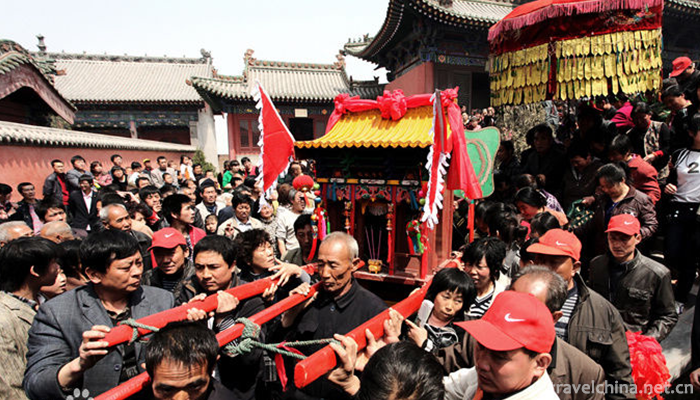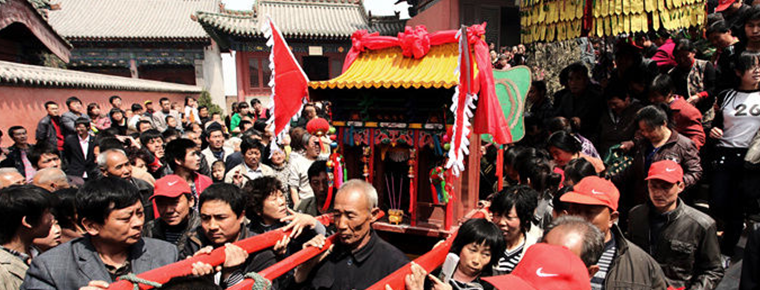Hongdongs custom of visiting relatives
Hongdongs custom of visiting relatives
The custom of walking relatives in Hongdong is a kind of Han traditional folk culture which spreads in Ganting, Wucun, Xincun, Longma and Wanan townships in Hongdong County and Yaodu District of Linfen City, Shanxi Province. It involves more than 20 villages and crosses the East and West banks of the Fenhe River. The local Han people are known as "going to relatives on March 3rd" and "taking aunts to meet their mothers", which are related to the legend of the marriage relationship between Emperor Yao's daughter "Nv Ying" and Shun. The first batch and the second batch of national intangible cultural heritage in Shanxi Province.
historical origin
As an ancient folk culture of the Han nationality, Hongdong's family-walking activities span five townships, Ganting, Wucun, Xincun, Longma and Wan'an, in two counties (districts) of Linfen City, Shanxi Province. They involve more than 20 villages and cross the East and West banks of the Fenhe River, with a wide range of influence.
There is a local legend about the activity of "receiving aunts and welcoming mothers" to visit relatives. The original name of the village is Zhoufu Village. Later, a ewe gave birth to a one-horned sheep. Its name is "Mao", which is a divine beast and has the ability to distinguish good from evil. As the Road History says, "Sex knows straight, knows guilty, and can not touch straight." The matter was known to Gao Tao, the sage of Shishicun and the judicial officer of Yao, and reported to Emperor Yao. King Yao of Pingyang, Dingdu, came to visit with his pregnant wife. Unexpectedly, his wife gave birth to female Ying in the land where she was born. Yao saw that there were God beasts and saints and babies in this area. He moved to live with his whole family and renamed the village as a goat otter. Shun Geng Li Shan is a well-known story in ancient books. Although there are more than 20 places in the name of Li Shan in China, the local people firmly believe that Shun cultivates in this Li Shan. They are favored by the visiting sage King Yao and marry E Huang and Nv Ying to Shun. Therefore, Otter and Lishan are the mother-in-law's and mother-in-law's families of the two goddesses respectively. Owing to the relationship of generations, Otter people call them "aunt", and Lishan and other places call them "mother-in-law". Every year on March 3rd of the lunar calendar, near the Qingming Dynasty, it is the day of grave sweeping and ancestor sacrifice. The goats pick them up from the calendar mountain to their mother's home and their relatives until April 28th (the birthday of King Yao). The calendars come to pay homage to King Yao and take the two mothers back. Then they will enter the busy season of agriculture.
(Atlas 2 of Hongtong's Family Visiting Customs Activities)
cultural meaning
First of all, the ceremony and legend of visiting relatives are important ways for the working people of the Han nationality to remember together and oral records of the evolution of regional history. Legend has a function of explanation. When people tend to obscure and forget history, history gradually evolves into memory and enters people's minds. When handed down from generation to generation, it gradually forms rich Han folklore. The legend of Yao and Shun and the explanation of the origin of the village name obviously have the nature of this common memory, which is also a warning to future generations not to forget history.
Secondly, the custom and legend of visiting relatives maintain a regional social order. Wherever people go during the activity, they are enthusiastic and pious, conveying a kind of social ethics, morality and taboos. Eating "waist meal" and staying in the village after dark have realized the process and purpose of family recognition and highlighted their attachment to family relations, which has played an important role in strengthening regional ties, especially in this society where the sense of space is becoming stronger and the interpersonal relationship is becoming more and more tense. Such family-visiting ceremonies will undoubtedly give people a lot of inspiration, about interpersonal and living space. Between. In short, the March 3 visiting ceremony has become an important belief and recreational activity besides farming and living in southern Shanxi, which affects people's attitude to life, values and relatives. It is a kind act for people to actively participate in and respond to the busy farming. It is a way to express their beliefs and wishes. It is also a way to vent their emotions. It seeks spiritual sustenance in their personal efforts and experiences, realizes the harmony between relatives and neighbours, and maintains their friendship with foreigners.
Inheritance situation
According to textual research, the earliest record of existence can only be seen that Shun Temple existed in Lishan during the Northern Song Dynasty (see Shanxi Tongzhi Temple). Therefore, the custom of "receiving aunts and welcoming their wives" should originate around the Song Dynasty. However, local people, local intellectuals and even government officials all believe that this is the true history and believe that the whole "receiving aunts and welcoming their wives" is true. Family visits have also been handed down from the Yao and Shun times, with a history of four to five thousand years. They are extremely proud of this and defend their beliefs with practical actions. Even during the period when such activities were strictly prohibited during the "Cultural Revolution", they still took risks and dressed up to secretly pick up their aunts. Many people were detained and imprisoned for this reason.


-
1.Donkey HamBurger
Donkey HamBurger is a popular traditional snack in North China. It originated in Baoding. Widely spread in the central Hebei Plain, the brine good donkey meat adds the old soup to join the crispy fire
Time 2018-11-07 -
2.Nanzhao Custom Island Dali
Nanzhao Custom Island in Dali is one of the three islands in Erhai Lake, located in Shuanglang Township at the southeast end of Eryuan County, the golden section of Cang Er National Scenic Area
Time 2019-01-06 -
3.Hunan Provincial Museum
Hunan Museum is the largest museum of history and art in Hunan Province. It covers an area of 49,000 square meters and has a total floor area of 91,000 square meters.
Time 2019-01-16 -
4.The Story of Barragan
Stories of witty figures of the Mongolian people in China. Long-term spread in Inner Mongolia, Xinjiang and other Mongolian areas. The protagonist Balagan Cang is the representative of the working peo
Time 2019-04-02 -
5.Tibetan Gesar Painted Stone Carvings
Tibetan Gesar painted stone carvings belong to a relic of Chinese Tibetan Gesar culture. They are mainly distributed in Seda, Shiqu and Danba counties in Ganzi Tibetan
Time 2019-04-06 -
6.Song of Sichuan river
Chuanjiang chant is a kind of traditional folk singing form that the shipworkers in Chuanjiang valley of Sichuan and Chongqing area lead the singing by the trumpeters for unified movement and rhythm
Time 2019-04-19 -
7.Fengyang flower drum
Fengyang flower drum is also known as "flower drum", "beating flower drum", "flower drum gong", "double drum" and so on. Fengyang flower drum originated in Linh
Time 2019-04-29 -
8.Jiaodong drum
Jiaodong Drum is a folk folk folk art form which originated in the coastal counties of Jiaodong Peninsula. It has a history of more than 260 years so far. It originated from the blind
Time 2019-05-06 -
9.Yangge Dance
Yangge is a popular and representative folk dance genre in China (mainly in the northern region). There are different appellations and styles in different regions. In folk, there are two kinds of appe
Time 2019-07-10 -
10.Chen Jingrun
Chen Jingrun (May 22, 1933 -1996 March 19th), male, Han, non party personages. Fujian Fuzhou Man, a contemporary mathematician.
Time 2019-09-07 -
11.Jiufeng Mountain Scenic Area
Jiufeng Mountain is located in Dabao Township in the northwest of Pengzhou. It is about 97 kilometers away from Chengdu, with an altitude of more than 3315 meters. It is the crown of Pengzhou mountains, a sacred and mysterious area
Time 2020-11-05 -
12.Dazhous secondary industry
In 2019, the added value of all industries in Dazhou is 46.35 billion yuan, an increase of 8.7% over the previous year, of which the added value of industries above Designated Size will increase by 9.6% (see Table 2). Among the industries above
Time 2020-12-20